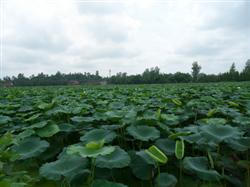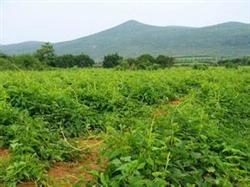Cultivation techniques of precocious Lotus Root

Hybrid lotus root and extra precocious lotus root were introduced. After several years of trial and demonstration, a new technique of protecting and cultivating lotus root with plastic film small arch shed was found. The technology can be planted early, put on the market early, and be harvested from the end of June to the beginning of July. Late rice can be planted after lotus root harvest, winter vegetables can be planted in time after late rice harvest, and lotus root can be planted the following year. The cultivation mode of lotus root, one late rice and one winter vegetable was formed, and the economic benefit was obviously improved. The techniques of protecting and cultivating lotus root in small arch shed with thin film are introduced as follows: 1. Selecting good fields and fertilizing soil lotus roots are generally suitable for planting in clay paddy fields with rich organic matter, deep and loose soil layer and strong water and fertility conservation. In the paddy field that was going to grow lotus root in the next year, 1500 kg of manure for human and livestock was applied per mu after late rice harvest, and dwarf resistant green cabbage was planted. When transplanting, it was poured with rare manure urine per mu, and ploughed after survival and turning green, and 15 kg of ammonium bicarbonate was used for water 1000 kg per mu or 1000 kg of rare manure urine. Since then, many times of topdressing will be carried out. By planting winter vegetables and fertilizing the soil, the soil is loose and the content of organic matter is high, so as to meet the fertilizer demand of early lotus root. 2. The daily average temperature of planting early lotus root is more than 12 ℃. The lotus root field is covered with a small arch shed with thin film, and the sowing time is from late February to early March. When the temperature is suitable, cover the film while planting on a windless sunny day. Choose non-mildew-free, non-broken, sturdy, neat, thin lotus root for planting. The planting density and seed consumption of early lotus root were higher than that of conventional planting. Its row spacing is 160cm, plant spacing is lOO cm, planting 400m / mu 450 holes, each hole 3, per mu lotus root head is 1200 Mel 1300, need to plant lotus root 300 Mel 400kg. When planting, the lotus root head of the side row is inward to prevent the lotus whip from extending out of the ridge; the positions of each row and species of lotus root are interlaced with each other and arranged in the shape of plum blossoms. The horizontal shallow oblique planting method is beneficial to the heating of lotus root seedlings and to facilitate germination. 3. Apply sufficient base fertilizer, skillfully apply topdressing base fertilizer 2000 kg per mu, potassium chloride 15 kg, phosphate fertilizer 50 kg per mu, phosphate fertilizer can be used as a kind of fertilizer at the edge of the hole. Three days after the film was removed, 15 kg of ammonium bicarbonate per mu or 1750 kg of feces and urine were applied to make milk fertilizer. After that, every 15 days, 7.5kg of urea or 1750 kg of human feces and urine were applied per mu as topdressing until lotus root was formed. When topdressing, shallow field water should be put properly, and it would be better to spread it around the lotus root bushes on a windless and sunny day. Prevent fertilizer from falling on the lotus leaf; if any fertilizer is scattered on the lotus leaf, rinse with clean water. The application of farm manure should be stepped into the mud to improve the soil temperature. 4. Field management 4.1 Water slurry management? The water level in the field should be from shallow to deep, and then from deep to shallow: at the initial stage of planting, it is appropriate to keep the surface of the field with shallow water of 3m / 5cm, so as to raise the soil temperature and facilitate germination. After exuberant growth, gradually deepen the water layer to 10mur15cm, knot stage, and then reduce to 3mur5cm. 4.2 greenhouse film management? The temperature at the initial stage of planting is low, and the greenhouse film should be covered strictly. The direction of the greenhouse film should be parallel to the normal wind direction to prevent the wind from blowing over the greenhouse film and freezing the lotus root seedlings. Before and after Ching Ming Festival, the temperature gradually rises. When the temperature rises to more than 20 ℃, the plastic film should be opened for ventilation during the day to prevent burns of bud leaves, and the film should be covered at night to keep warm. In the future, with the increase of temperature, it is necessary to increase ventilation and refine seedlings. When it comes to standing leaves, choose a windless sunny day and uncover the film comprehensively after 4: 00 p. M. Before uncovering the film, the seedlings should be protected by deep water to prevent excessive loss of water. Three days after the film was uncovered, the water level was lowered, weeds were pulled out, and weaning fertilizer was applied in time. The lotus whip close to the ridge of the field should be turned at noon when the stems and leaves are soft. 4.3 remove old leaves and folded flowers? After the standing leaves were covered with the field, the ventilation became worse, the light was insufficient, and the assimilation decreased. At this time, the aging leaves can be removed. In order to avoid nutrient consumption, the pedicel can be twisted after budding, but not broken, in order to prevent Rain Water from invading. 4.4 Pest control? The common pests are aphids and Spodoptera litura, which can be sprayed with 1500 times of dimethoate emulsion and 6000 Mel 7000 times of Spodoptera litura. The common diseases are brown streak, black root disease, rot disease and so on. The control methods are as follows: select disease-free lotus root, avoid continuous cropping as far as possible, apply fully mature farm manure, and apply 75-lOO kg quicklime per mu. When irrigation, be careful not to pour in the field water that has just been applied with herbicides, so as to avoid drug damage. 5. Harvest and seed 5.1 harvesting early lotus roots can dig fresh and tender lotus roots at the end of June. Because the soil of hybrid lotus root is shallow, you can touch lotus root with hand with water when digging lotus root. You can choose to touch the lotus root big or small, or you can touch the whole piece. Get all the late rice before transplanting. When digging lotus root, the petiole is chopped off with a knife and stepped on to make fertilizer in the field. The lotus leaves can be plucked, dried and stored for other use. Generally, about 166.7 square meters of lotus root should be reserved per mu. Planting lotus root can survive the winter in the field. Keep the soil moist and prevent frost damage when overwintering. When planting in the second year, it will be planted as soon as it is dug, and the excess lotus root can be supplied to the market.
- Prev

How to prevent diseases of Chinese yam in high temperature and rainy period
First, the growing period is generally planted from February to March, and harvesting begins from September to December. 2. Main cultivation techniques 1. Soil selection: sandy loam soil with loose and deep soil and watered by water source should be selected. 2, seedling preparation and treatment (1) the use of Chinese yam castor planting: at present,.
- Next

Key points of management in ginger expansion period
Key points of management in ginger expansion period
Related
- Where is it suitable to grow horseradish in China? it is expected to see the middle altitude horseradish in Alishan.
- How to prevent tomato virus disease reasonably? (Control methods included)
- Many people like to plant towel gourd on the balcony. What are the main points of this method and management?
- What crops can chili peppers be mixed with?
- Fertilization techniques and matters needing attention in Tomato
- What are the grafting techniques for peach seedlings in spring?
- Harm and control methods of root swelling disease of Chinese cabbage
- What are the pests of sweet potatoes? How to prevent and cure it?
- Symptoms, causes and Control methods of navel Rot in Tomato
- The cause of "Cucumber rotten bibcock" in Farmers' planting Cucumber and its Control Plan

